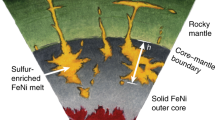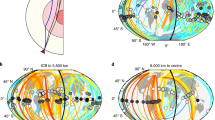Abstract
Palaeomagnetic measurements of meteorites1,2,3,4,5 suggest that, shortly after the birth of the Solar System, the molten metallic cores of many small planetary bodies convected vigorously and were capable of generating magnetic fields6. Convection on these bodies is currently thought to have been thermally driven7,8, implying that magnetic activity would have been short-lived9. Here we report a time-series palaeomagnetic record derived from nanomagnetic imaging10 of the Imilac and Esquel pallasite meteorites, a group of meteorites consisting of centimetre-sized metallic and silicate phases. We find a history of long-lived magnetic activity on the pallasite parent body, capturing the decay and eventual shutdown of the magnetic field as core solidification completed. We demonstrate that magnetic activity driven by progressive solidification of an inner core11,12,13 is consistent with our measured magnetic field characteristics and cooling rates14. Solidification-driven convection was probably common among small body cores15, and, in contrast to thermally driven convection, will have led to a relatively late (hundreds of millions of years after accretion), long-lasting, intense and widespread epoch of magnetic activity among these bodies in the early Solar System.
This is a preview of subscription content, access via your institution
Access options
Subscribe to this journal
Receive 51 print issues and online access
$199.00 per year
only $3.90 per issue
Buy this article
- Purchase on Springer Link
- Instant access to full article PDF
Prices may be subject to local taxes which are calculated during checkout




Similar content being viewed by others
References
Tarduno, J. A. et al. Evidence for a dynamo in the main group pallasite parent body. Science 338, 939–942 (2012)
Carporzen, L. et al. Magnetic evidence for a partially differentiated carbonaceous chondrite parent body. Proc. Natl Acad. Sci. USA 108, 6386–6389 (2011)
Fu, R. R. et al. An ancient core dynamo in asteroid Vesta. Science 338, 238–241 (2012)
Weiss, B. P., Fong, L. E., Vali, H., Lima, E. A. & Baudenbacher, F. J. Paleointensity of the ancient Martian magnetic field. Geophys. Res. Lett. 35, L23207 (2008)
Garrick-Bethell, I., Weiss, B. P., Shuster, D. L. & Buz, J. Early lunar magnetism. Science 323, 356–359 (2009)
Stevenson, D. J. Planetary magnetic fields: achievements and prospects. Space Sci. Rev. 152, 651–664 (2010)
Elkins-Tanton, L. T., Weiss, B. P. & Zuber, M. T. Chondrites as samples of differentiated planetesimals. Earth Planet. Sci. Lett. 305, 1–10 (2011)
Weiss, B. P. et al. Magnetism on the angrite parent body and the early differentiation of planetesimals. Science 322, 713–716 (2008)
Weiss, B. P., Gattacceca, J., Stanley, S., Rochette, P. & Christensen, U. R. Paleomagnetic records of meteorites and early planetesimal differentiation. Space Sci. Rev. 152, 341–390 (2010)
Bryson, J. F. J. et al. Nanopaleomagnetism of meteoritic Fe-Ni studied using X-ray photoemission electron microscopy. Earth Planet. Sci. Lett. 396, 125–133 (2014)
Fearn, D. R. & Loper, D. E. Compositional convection and stratification of Earth’s core. Nature 289, 393–394 (1981)
Nimmo, F. in Treatise on Geophysics (ed. Schubert, G. ) 8.02, 31–65 (Elsevier, 2007)
Olson, P. & Christensen, U. R. Dipole moment scaling for convection-driven planetary dynamos. Earth Planet. Sci. Lett. 250, 561–571 (2006)
Yang, J., Goldstein, J. I. & Scott, E. R. D. Main-group pallasites: thermal history, relationship to IIIAB irons, and origin. Geochim. Cosmochim. Acta 74, 4471–4492 (2010)
Nimmo, F. Energetics of asteroid dynamos and the role of compositional convection. Geophys. Res. Lett. 36, L10210 (2009)
Anders, E. Origin, age and composition of meteorites. Space Sci. Rev. 3, 583–714 (1964)
Goldstein, J. I., Scott, E. R. D. & Chabot, N. L. Iron meteorites: crystallization, thermal history, parent bodies, and origin. Chem. Erde Geochem. 69, 293–325 (2009)
Néel, L., Pauleve, J., Pauthenet, R., Laugier, J. & Dautreppe, D. Magnetic properties of nickel-iron alloys bombarded by neutrons in a magnetic field. J. Appl. Phys. 35, 873–876 (1964)
Clarke, R. S. & Scott, E. R. D. Tetrataenite-ordered FeNi, a new mineral in meteorites. Am. Mineral. 65, 624–630 (1980)
Bryson, J. F. J., Church, N. S., Kasama, T. & Harrison, R. J. Nanomagnetic intergrowths in Fe-Ni meteoritic metal: the potential for time-resolved records of planetesimal dynamo fields. Earth Planet. Sci. Lett. 388, 237–248 (2014)
Scott, E. R. D. The nature of dark-etching rims in meteoritic taenite. Geochim. Cosmochim. Acta 37, 2283–2294 (1973)
Uehara, M., Gattacceca, J., Leroux, H., Jacob, D. & van der Beek, C. J. Magnetic microstructures of metal grains in equilibrated ordinary chondrites and implications for paleomagnetism of meteorites. Earth Planet. Sci. Lett. 306, 241–252 (2011)
Albertsen, J. F. Tetragonal lattice of tetrataenite (ordered Fe-Ni, 50–50) from 4 meteorites. Phys. Scr. 23, 301–306 (1981)
Stöhr, J. Exploring the microscopic origin of magnetic anisotropies with X-ray magnetic circular dichroism (XMCD) spectroscopy. J. Magn. Magn. Mater. 200, 470–497 (1999)
van der Laan, G. Applications of soft X-ray magnetic dichroism. J. Phys. Conf. Ser. 430, 012127 (2013)
Stöhr, J., Padmore, H., Anders, S., Stammler, T. & Scheinfein, M. Principles of X-ray magnetic dichroism spectromicroscopy. Surf. Rev. Lett. 5, 1297–1308 (1998)
Yang, J. & Goldstein, J. I. The formation of the Widmanstätten structure in meteorites. Meteorit. Planet. Sci. 40, 239–253 (2005)
Williams, Q. Bottom-up versus top-down solidification of the cores of small solar system bodies: constraints on paradoxical cores. Earth Planet. Sci. Lett. 284, 564–569 (2009)
Sterenborg, M. G. & Crowley, J. W. Thermal evolution of early solar system planetesimals and the possibility of sustained dynamos. Earth Planet. Sci. Lett. 214, 53–73 (2013)
Laneuville, M. et al. A long-lived lunar dynamo powered by core crystallization. Earth Planet. Sci. Lett. 401, 251–260 (2014)
Ohldag, H. et al. Spectroscopic identification and direct imaging of interfacial magnetic spins. Phys. Rev. Lett. 87, 247201 (2001)
Hevey, P. J. & Sanders, I. S. A model for planetesimal meltdown by 26Al and its implications for meteorite parent bodies. Meteorit. Planet. Sci. 41, 95–106 (2006)
Haack, H., Rasmussen, K. L. & Warren, P. H. Effects of regolith/megaregolith insulation on the cooling histories of differentiated asteroids. J. Geophys. Res. 95, 5111–5124 (1990)
Warren, P. H. Ejecta-megaregolith accumulation on planetesimals and large asteroids. Meteorit. Planet. Sci. 46, 53–78 (2011)
Sahijpal, S. Soni, P. & Gupta, G. Numerical simulations of the differentiation of accreting planetesimals with 26Al and 60Fe as the heat sources. Meteorit. Planet. Sci. 42, 1529–1548 (2007)
Acknowledgements
We acknowledge the Helmholtz-Zentrum Berlin for the use of the synchrotron radiation beamtime at beamline UE49 of BESSY II. The research leading to these results has received funding from the European Research Council under the European Union’s Seventh Framework Programme (FP/2007-2013)/ERC grant agreement numbers 320750 and 312284, the Natural Environment Research Council, Fundación ARAID and the Spanish MINECO MAT2011-23791. We thank the Natural History Museum, London, and the Sedgwick Museum of Earth Sciences, University of Cambridge, for samples. We also thank J. Tarduno for discussions concerning magnetic shielding.
Author information
Authors and Affiliations
Contributions
J.F.J.B., C.I.O.N., J.H.-A., F.K., G.v.d.L. and R.J.H. collected the XPEEM images. T.K. and H.A. collected the SEM images. J.F.J.B. and C.I.O.N. analysed the XPEEM images. J.F.J.B. and F.N. performed the planetary cooling and dynamo generation simulations. J.F.J.B., R.J.H. and F.N. wrote the paper with contributions from all other authors.
Corresponding author
Ethics declarations
Competing interests
The authors declare no competing financial interests.
Extended data figures and tables
Extended Data Figure 1 A 15-µm field-of-view XPEEM image of the kamacite, tetrataenite rim, CZ and aligned CZ in the Imilac meteorite.
The boundaries between the kamacite and tetrataenite rim and the tetrataenite rim and CZ are marked as solid black lines, and the boundary between the CZ and aligned CZ is marked as a dashed line. Note that the interface between the CZ and fine aligned CZ is abrupt and parallel to the tetrataenite rim. The in-plane orientation of the X-ray beam is included as an arrow; the beam was 16° out of plane. This orientation applies to all images.
Extended Data Figure 2 Representative SEM images of the CZ in the pallasites.
Coarser tetrataenite islands in the Imilac (a) and Esquel (b) meteorites. The regions corresponding to Fig. 1 are included (red boxes). The CZ is unclear and island sizes could not be extracted beyond four and six regions of the Imilac and Esquel meteorites, respectively. The average island size of each region is included in Extended Data Table 1.
Extended Data Figure 3 Additional XPEEM images and pixel intensity histograms for the Imilac meteorite.
a–c, 5-µm field-of-view XPEEM images from three areas of the Imilac meteorite. These areas, along with Fig. 1a, passed the selection criteria outlined in the ‘Experimental analysis’ section of the Methods. Note that the magnetic patterns vary between images. d, Average pixel intensity histograms calculated from the four images of the Imilac meteorite. The dashed line is the optimized fit curve for the best fit for region 1; the fits for other regions were not included (to reduce clutter), but all displayed similar agreement to their experimental counterpart.
Extended Data Figure 4 As for Extended Data Fig. 3 but for the Esquel meteorite.
Extended Data Figure 5 Flow diagram of the procedure used to identify the intensity and orientation of the field recorded by each region, as described in the Methods.
The blue box represents the input to the procedure (approximate field intensity). The orange boxes represent the parts of the procedure used to deduce the approximate direction of the recorded field. The red boxes represent the part of the procedure used to optimize the direction and intensity estimates. The green box represents the final outputs.
Extended Data Figure 6 200-km-radius body cooling rate.
Values derived from Fig. 4. Cooling rates between 0 K Myr−1 and 10 K Myr−1 are depicted by the colour scale; any value greater than 10 K Myr−1 is depicted by the dark red colour. The green line is the 800-K contour from Fig. 4, which corresponds to the temperature of the cooling rates inferred from the relationship to island size14. The core cools at a rate of between 0 K Myr−1 and 3.6 K Myr−1.
Extended Data Figure 7 Planetary magnetic parameters calculated from the dynamo generation model.
a, Local Rossby number, Rol, showing the combination of parameters resulting in predominantly dipolar (red region) to multipolar (blue region) fields. b, Magnetic Reynolds number, Rem, showing the combination of parameters that do (blue region) and do not (red region) result in dynamo activity. c, Dipolar Lorentz number, Lodip, showing the combination of parameters that do (blue region) and do not (red region) produce Lodip > 10−5. A four-hour rotation period is highlighted in each figure.
Extended Data Figure 8 Additional planetary cooling models.
a, b, Temperatures (a) and cooling rates (b) from the conductive cooling model with a 100-km radius. The cooling rate at 800 K (green line) reaches the inferred values of the Imilac or the Esquel meteorites after complete core solidification. c, d, Temperatures (c) and cooling rate (d) from the conductive cooling model with a 300-km radius. The depths (horizontal black lines) corresponding to the inferred cooling rates at 800 K (green line) for the Imilac and Esquel meteorites reach the tetrataenite formation temperature (593 K, red line) before the core solidification starts.
Related audio
41586_2015_BFnature14114_MOESM91_ESM.mp3
Reporter Lizzie Gibney speaks to researcher James Bryson about using meteorites to study the history of the solar system.
Supplementary information
Supplementary Information
This file contains Supplementary Methods, Supplementary Results, a Supplementary Discussion and Supplementary References. (PDF 920 kb)
Source data
Rights and permissions
About this article
Cite this article
Bryson, J., Nichols, C., Herrero-Albillos, J. et al. Long-lived magnetism from solidification-driven convection on the pallasite parent body. Nature 517, 472–475 (2015). https://doi.org/10.1038/nature14114
Received:
Accepted:
Published:
Issue Date:
DOI: https://doi.org/10.1038/nature14114
This article is cited by
-
The Psyche Magnetometry Investigation
Space Science Reviews (2023)
-
Ferrovolcanism on metal worlds and the origin of pallasites
Nature Astronomy (2019)
-
A potential hidden layer of meteorites below the ice surface of Antarctica
Nature Communications (2016)
Comments
By submitting a comment you agree to abide by our Terms and Community Guidelines. If you find something abusive or that does not comply with our terms or guidelines please flag it as inappropriate.



